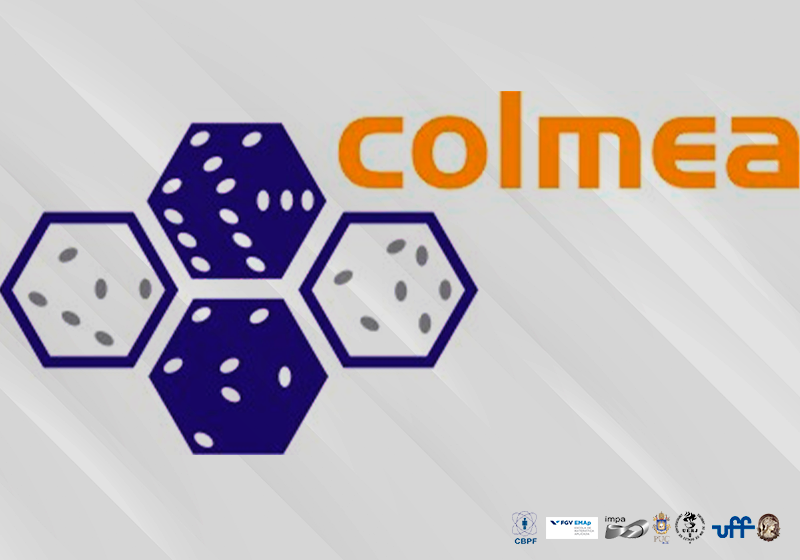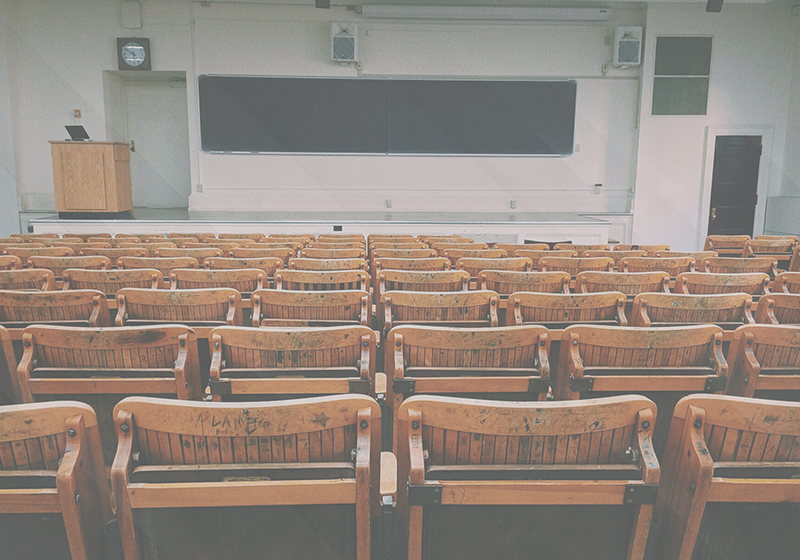 Data: 22/11/2023
Data: 22/11/2023
Horário: a partir das 14:00h
Local: Sala de reuniões do Decanato do CTC, 12 º andar do prédio Cardeal Leme, PUC-Rio
Nesta ocasião teremos palestras de Philip Thompson (FGV EMAp) e Oliver Riordan (Oxford).
Programa:
14:00 h - 15:20h - Philip Thompson (FGV EMAp)
Outlier-robust additive matrix decomposition and robust matrix completion
Abstract: We study least-squares trace regression when the parameter is the sum of a $r$-low-rank matrix with a $s$-sparse matrix and a fraction $\epsilon$ of the labels is corrupted. For subgaussian distributions, we highlight three needed design properties, each one derived from a different process inequality: the ``product process inequality'', ``Chevet's inequality'' and the ``multiplier process inequality''. Jointly, these properties entail the near-optimality of a tractable estimator with respect to the effective dimensions for the low-rank and sparse components, $\epsilon$ and the failure probability $\delta$. ... Our estimator is adaptive to $(s,r,\epsilon,\delta)$ and, for fixed absolute constant $c>0$, it attains the mentioned rate with probability $1-\delta$ uniformly over all $\delta > exp(-cn)$. Disconsidering matrix decomposition, our analysis also entails optimal bounds for a robust estimator adapted to the noise variance. Finally, we consider robust matrix completion. We highlight a new property for this problem: one can robustly and optimally estimate the incomplete matrix regardless of the magnitude of the corruption. Our estimators are based on ``sorted'' versions of Huber's loss. We present simulations matching the theory. In particular, it reveals the superiority of ``sorted'' Huber's losses over the classical Huber's loss.
15:40h - 17:00h - Oliver Riordan (Oxford)
The chromatic number of random graphs
17:00h - Discussão e lanche
Todos são muito bem-vindos.
Informações mais completas sobre o COLMEA podem ser encontradas AQUI.
O comitê organizador:
Americo Cunha (UERJ)
Evaldo M.F. Curado (CBPF)
João Batista M. Pereira (UFRJ)
Leandro P. R. Pimentel (UFRJ)
Maria Eulalia Vares (UFRJ)
Nuno Crokidakis (UFF)
Roberto I. Oliveira (IMPA)
Simon Griffiths (PUC-Rio)
Yuri F. Saporito (FGV-EMAp)
 Data: 17/05/2023
Data: 17/05/2023
Horário: 14:15h
Local: Auditório 1 - IMPA. Estrada Dona Castorina 110. Jardim Botânico. Rio de Janeiro.
Nosso próximo encontro do COLMEA será no dia 17 de maio (quarta-feira), no IMPA. Na ocasião teremos a seguinte programação:
14:15h - Andressa Cerqueira (UFSCar)
Community detection in weighted networks
15:50h - Gabor Lugosi (ICREA - U. Pompeu Fabra)
Problems in network archaeology: root finding and broadcasting
Resumo:
Community detection in weighted networks
Andressa Cerqueira (UFSCar)
Network models have received increasing attention from the statistical community, in particular in the context of analyzing and describing the interactions of complex random systems. In this context, community structures can be observed in many networks where the nodes are clustered in groups with the same connection patterns. In this talk, we address the community detection problem for weighted networks in the case where, conditionally on the node labels, the edge weights are drawn independently from a Gaussian random variable with mean and variance depending on the community labels of the edge endpoints. We will present a fast and tractable EM algorithm to recover the community labels that achieves the optimal error rate.
Problems in network archaeology: root finding and broadcasting
Gábor Lugosi (ICREA - U. Pompeu Fabra)
Large networks are often naturally modeled by random processes in which nodes of the network are added sequentially, according to some stochastic rule. Uniform and preferential attachment trees are among the simplest examples of such dynamically growing networks. The statistical problems we address in this talk regard discovering the past of the network when a present-day snapshot is observed. We present results that show that, even in gigantic networks, a lot of information is preserved from the very early days. In particular, we discuss the problem of finding the root and the broadcasting problem.
Todos são muito bem-vindos.
O comitê organizador:
Americo Cunha (UERJ)
Evaldo M. F. Curado (CBPF)
João Batista M. Pereira (UFRJ)
Leandro P. R. Pimentel (UFRJ)
Maria Eulalia Vares (UFRJ)
Nuno Crokidakis (UFF)
Roberto I. Oliveira (IMPA)
Simon Griffiths (PUC-Rio)
Yuri F. Saporito (FGV EMAp)
Mais informações sobre o COLMEA podem ser encontradas através da homepage AQUI.
 Data: 13/04/2022
Data: 13/04/2022
Horário: 14:00h
Palestrante: Mariana M. Vale (IB-UFRJ) e Paulo Artaxo (IF-USP)
Local: Transmissão online
Confira AQUI o link para a transmissão.
Mariana M. Vale (IB-UFRJ)
A emergência de novas doenças infecciosas tem crescido enormemente nas últimas décadas, algumas ganhando dimensões pandêmicas. A maioria dessas doenças são zoonóticas na sua origem, ou seja, são causadas por patógenos que passaram de animais, muitas vezes silvestres, para o homem. A resposta tem focado fortemente no controle da disseminação dessas doenças, uma vez que emergem, e muito pouco na sua prevenção. A palestra apresenta os resultados de estudos que propõem e estimam o custo da prevenção de pandemias, em escala global, através de quatro principais ações ambientais. As ações são tecnicamente simples e seu custo é 1/20 do custo anual associado a novas doenças infecciosas de origem zoonótica. A palestra explora também alguns aspectos do risco de emergência e custo de prevenção de novas doenças infecciosas com potencial pandêmico no Brasil.
Paulo Artaxo (IF-USP)
A humanidade está em transição. Não sabemos transição para o que exatamente. Pode ser que tenhamos um aumento de temperatura global de 3 graus, com danos irreparáveis aos ecossistemas, que podem comprometer nossa sociedade. Ou um novo modelo socio-econômico que seja sustentável, com melhor justiça social e redução de desigualdades. Precisamos construir um sistema de governança global para guiar a humanidade nesta trajetória. Será possível? Como a Ciência pode ajudar nesta transição? São questões amplas e estratégicas para a humanidade que precisamos discutir.
Americo Cunha (UERJ)
Augusto Q. Teixeira (IMPA)
Evaldo M. F. Curado (CBPF)
João Batista M. Pereira (UFRJ)
Leandro P. R. Pimentel (UFRJ)
Maria Eulalia Vares (UFRJ)
Nuno Crokidakis (UFF)
Simon Griffiths (PUC-Rio)
Acesse AQUI para mais informações sobre o COLMEA.
 Data: 05/04/2023
Data: 05/04/2023
Horário: 14:00h
Palestrante: Leonardo Soares Bastos (PROCC - Fiocruz) e Wanderson Luiz Silva (IGEO - UFRJ)
14:00h: Leonardo Soares Bastos (PROCC - Fiocruz)
"Corrigindo atraso de notificação de doenças infecciosas: Nowcasting bayesiano e extensões"
15:40h: Wanderson Luiz Silva (IGEO - UFRJ)
"Mudanças climáticas: Tendências observadas e cenários futuros de extremos climáticos"
Mais informações sobre o COLMEA podem ser encontradas através da homepage AQUI.
 Data: 28/10/2021
Data: 28/10/2021
Hora: 13:00h
Palestrantes: Marcelo R. Hilário (UFMG) e Nuno A. M. Araújo (Universidade de Lisboa)
Confira AQUI o link para a transmissão. Haverá transmissão pelo canal do YouTube COLMEA UFRJ.
O comitê organizador:
Americo Cunha (UERJ)
Augusto Q. Teixeira (IMPA)
Evaldo M. F. Curado (CBPF)
João Batista M. Pereira (UFRJ)
Leandro P. R. Pimentel (UFRJ)
Maria Eulalia Vares (UFRJ)
Nuno Crokidakis (UFF)
Simon Griffiths (PUC-Rio)
Acesse AQUI para mais informações sobre o COLMEA.
Marcelo R. Hilário (UFMG)
Percolation on the Euclidean d-dimensional lattice has been studied for over sixty years and is still a fascinating source of interesting mathematical problems. The fact that this model undergoes a non-trivial phase transition is well-understood since the early studies in the Bernoulli setting, where the lattice is regular and there are no inhomogeneities on the parameters. One way to introduce random disorder is, for example, either passing to a dilute lattice where lower dimensional affine hyperplanes are removed or, alternately, introducing inhomogeneities on the parameter along such hyperplanes. In these situations, even to establish that non-trivial phase transition takes place may be a hard task. In this talk we review some recent results on this topic and discuss some open problems.
Nuno A. M. Araújo (Universidade de Lisboa)
Three-dimensional shells can be synthesized from the spontaneous self-folding of two-dimensional templates of interconnected panels, called nets. To design self-folding, one first needs to identify what are the nets that fold into the desired structure. In principle, different nets can fold into the same three-dimensional structure. However, recent experiments and numerical simulations show that the stochastic nature of folding might lead to misfolding and so, the probability for a given net to fold into the desired structure (yield) depends strongly on the topology of the net and experimental conditions. Thus, the focus has been on identifying what are the optimal nets that maximize the yield. But, what about the folding time? For practical applications, it is not only critical to reduce misfolding but also to guarantee that folding occurs in due time. Here, we consider as a prototype the spontaneous folding of a pyramid. We find that the total folding time is a non-monotonic function of the number of faces, with a minimum for five faces. The motion of each face is consistent with a Brownian process and folding occurs through a sequence of irreversible binding events that close edges between pairs of faces. The first edge closing is well-described by a first-passage process in 2D, with a characteristic time that decays with the number of faces. By contrast, the subsequent edge closings are all first-passage processes in 1D and so the time of the last one grows logarithmically with the number of faces. It is the interplay between these two different sets of events that explains the non-monotonic behavior. Implications in the self-folding of more complex structures are discussed.
